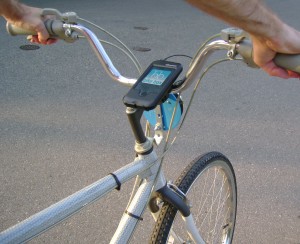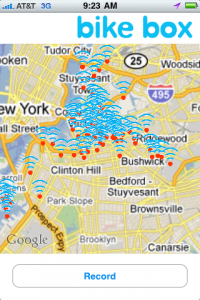Bike Box
 Over the summer, we launched a location-aware iPhone app we called Bike Box. Participants were able to borrow bicycles equipped with speakers and a phone mount and ride around central Brooklyn. The app allowed users to listen to a curated collection of site-specific audio content provided by a variety of audio artists. Users could also record and contribute their own site-specific audio.
Over the summer, we launched a location-aware iPhone app we called Bike Box. Participants were able to borrow bicycles equipped with speakers and a phone mount and ride around central Brooklyn. The app allowed users to listen to a curated collection of site-specific audio content provided by a variety of audio artists. Users could also record and contribute their own site-specific audio.
Among the things we grappled with while developing this project was how to use smartphone technology to enhance rather than replace a user’s experience of physical space. The intention of many apps is to bring the world to the user, rather than the other way around. The tendency of such apps is to de-spatialize or trans-spatialize the user, allowing her to review, survey, or experience spaces without moving. To put this in terms that Paul Virilio might appreciate, this is the tendency of an app—or mobile media in general—toward a spatio-temporal totalitarianism. “If in preindustrial eras the low speeds of various vehicles structured and geometrized the social landscape,” Virilio writes in Bunker Archaeology, “since the acquisition of high speeds… it is here, and not over there [emphasis added], that the critical is from now on played out.” To encourage mobility, exploration, and discovery, to insist on the “here-ness” of spatial media, we designed the app to allow users to listen to audio tags only by physically encountering the tagged spaces. For Bike Box, there is no content without negotiating physical space. In addition, we designed the app so that there can be no overlap of audio tags. Rather, a participant who adds a tag “owns” a 30 meter sphere of space. Among other things, this encourages a centrifugal or expansive relationship to space, propelling participants ever onward and outward toward unexplored and “unclaimed” territories.
The meaning of the term “space” is a complex one. On the one hand, one can argue that Bike Box opens a new space for communication, broadcast and social struggle, and on the other hand, this space may only be the virtual space of capitalism created for the purpose of being colonized. Geo-locative space is absolute space, as David Harvey puts it in his book Spaces of Global Capitalism: “[absolute space] is fixed and we record or plan events within its frame…. Socially this is the space of private property and other bounded territorial designations.”

Yet Bike Box uses a space that is still somewhat open, not yet occupied or regulated by the industry or the state. For example, we did not submit our application to the App Store and were able to distribute it via the iPhone configuration tool without Apple’s benediction. Mobile technology is still in its infancy and it is still possible to utilize this emerging technology as a “temporary autonomous zone.”
Another tendency we hoped to work against is the notion of an app as a private and intimate experience. Though users could listen to audio through headphones, we encouraged them to borrow one of the bikes we had equipped with speakers. The bikes served as broadcasting units, allowing riders to share their listening experience with friends and passersby. The speakers allowed the audio content to extend into the space. For the few moments the audio tag plays through the speaker, it becomes spatialized—no longer just a response to or gloss on the tagged space, but a part of the experience of that space.
The performative acts inherent in participating in a mobile game or interacting with a portable networked computer in public space is a rich area for research. This research could include such genres as flash mobs or even public cell phone use. Should we begin looking at this expression as a type of performance? It’s obvious that ubiquitous computing, mobile media, and invisible technologies like GPS and radio-frequency identification (RFID) are undermining concepts of public space and changing our notions of privacy. By utilizing high-powered speakers, Bike Box emphasized this extension into public space.
The advent of a new technology usually presents the possibility to repackage old media. This way, businesses can sell the same idea in a different package. The profit-motive aside, it behooves us to consider what new forms of communication and community are possible as a result of technologies such as smartphones and the availability of location-aware data. The new web standard (HTML-5) incorporates geolocation, meaning that it will be easier to target specific users in terms of their location. In conceiving Bike Box, we were interested in poetic responses to locations, be they field recordings, fictional narratives or interpretive audio. Participants were therefore enabled to contribute whatever audio they wished. The content we culled was more diverse than we had imagined it could be. For all participants it seemed important that the audio be either produced locally or by a local person. As geolocation becomes attached to identification, the concept of a local acquires new meaning and becomes an important ingredient in cultural narratives.



This is fascinating and I am always interested in the manner in which geography can be rearticulated by a new interpretive technology, whether it be personal electronics or grafitti. Of course this will bring up issues of power and control, but for a moment I would like to bracket that conversation and ask if the two authors would share a few remarks from participants. While many may think of this as the preliminary talking buildboards and spaces of sci fi films, something that is always painted in totalitarian light, this seems fun. What did participants report? Did they think it was fun? Were they disturbed?
Hi Tim,
We had to show participants how everything worked before they took the bicycles out. Most people had a good time with the project.
The main issue with something like this is getting people to record their own audio. Something about using ones voice seems more personal than just texting or commenting on something in writing.
Most participants were just listeners. They did not contribute content.